Investigating the Static and Dynamic Mechanical Properties of Fiber-Reinforced Concrete Incorporating Recycled Carbon Fiber and Modified Basic Oxygen Furnace Slag Aggregate
Abstract
1. Introduction
2. Result and Discussion
2.1. Workability
2.2. Shrinkage Behavior
2.3. Compressive Strength
2.4. Flexural Strength
2.5. Splitting Tensile Strength
2.6. Impact Resistance
2.7. High-Strain-Rate Behavior
3. Materials
3.1. Recycled Carbon Fiber Preparation and Characterization
3.2. Modified Basic Oxygen Furnace Slag and Natural Aggregate
3.3. Concrete Mix Proportions and Specimen Preparation
4. Experimental Method
4.1. Slump Test
4.2. Shrinkage Test
4.3. Compressive Test
4.4. Flexural Test
4.5. Splitting Tensile Test
4.6. Drop Weight Test
4.7. Stress-Reversal Split Hopkinson Pressure Bar Test
5. Conclusions
- SEM combined with EDS analysis revealed that the RCF obtained through MAP exhibited a surface carbon content of approximately 99.8%, indicating that MAP is an effective method for removing residual resin and recovering high-purity carbon fibers from CFRP waste.
- Replacing natural aggregates with MBOF in concrete reduced slump due to the angular shape and higher water absorption of MBOF. However, mechanical performance was significantly improved, with compressive, flexural, and splitting tensile strengths increasing by approximately 34.01%, 16.75%, and 9.37%, respectively.
- Incorporating 1 wt% of RCF with lengths of 6 mm and 12 mm into MBOF concrete further enhanced mechanical properties. Compared to fiber-free MBOF concrete, compressive strength increased by 3.03% and 13.77%, flexural strength by 14.50% and 19.74%, and splitting tensile strength by 2.60% and 25.84%, respectively. These results indicate that MBOF concrete reinforced with 12 mm RCF outperforms its 6 mm counterpart in all evaluated strength parameters.
- The incorporation of 1 wt% RCF with lengths of 6 mm and 12 mm into MBOF concrete significantly improved impact resistance under a 50 J impact energy level. The impact number increased by approximately 6.81 times and 12.67 times, respectively, compared to the fiber-free specimen (I-M). Notably, the specimen reinforced with 12 mm RCF demonstrated superior energy absorption capacity and mechanical performance.
- The SRSHPB test results revealed that MBOF concrete reinforced with 12 mm fibers (R-M-RCFL12) exhibited greater dynamic compressive strength than the specimens reinforced with 6 mm RCF (R-M-RCFL6). As gas pressure increased, the corresponding strain rate also rose, leading to an enhancement in dynamic compressive strength and dynamic increase factor (DIF). These results confirm the strain rate sensitivity of RCF-reinforced MBOF concrete under high strain-rate loading.
Author Contributions
Funding
Data Availability Statement
Conflicts of Interest
References
- Liu, Z.; Deng, Z.; Davis, S.J.; Giron, C.; Ciais, P. Monitoring global carbon emissions in 2021. Nat. Rev. Earth Environ. 2022, 3, 217–219. [Google Scholar] [CrossRef]
- Ghorbani, B.; Zendehboudi, S.; Afrouzi, Z.A. Multi-objective optimization of an innovative integrated system for production and storage of hydrogen with net-zero carbon emissions. Energy Convers. Manag. 2023, 276, 116506. [Google Scholar] [CrossRef]
- Mehmood, S.; Zaman, K.; Khan, S.; Ali, Z. The role of green industrial transformation in mitigating carbon emissions: Exploring the channels of technological innovation and environmental regulation. Energy Built Environ. 2024, 5, 464–479. [Google Scholar] [CrossRef]
- Cousins, D.S.; Suzuki, Y.; Murray, R.E.; Samaniuk, J.R.; Stebner, A.P. Recycling glass fiber thermoplastic composites from wind turbine blades. J. Clean. Prod. 2019, 209, 1252–1263. [Google Scholar] [CrossRef]
- Hadigheh, S.A.; Ke, F.; Kashi, S. 3D acid diffusion model for FRP-strengthened reinforced concrete structures: Long-term durability prediction. Constr. Build. Mater. 2020, 261, 120548. [Google Scholar] [CrossRef]
- Pinto, F.; Boccarusso, L.; De Fazio, D.; Cuomo, S.; Durante, M.; Meo, M. Carbon/hemp bio-hybrid composites: Effects of the stacking sequence on flexural, damping and impact properties. Compos. Struct. 2020, 242, 112148. [Google Scholar] [CrossRef]
- De Fazio, D.; Boccarusso, L.; Formisano, A.; Viscusi, A.; Durante, M. A review on the recycling technologies of fibre-reinforced plastic (FRP) materials used in industrial fields. J. Mar. Sci. Eng. 2023, 11, 851. [Google Scholar] [CrossRef]
- Guo, R.; Li, C.; Xian, G. Water absorption and long-term thermal and mechanical properties of carbon/glass hybrid rod for bridge cable. Eng. Struct. 2023, 274, 115176. [Google Scholar] [CrossRef]
- Zhang, J.; Lin, G.; Vaidya, U.; Wang, H. Past, present and future prospective of global carbon fibre composite developments and applications. Compos. Part B Eng. 2023, 250, 110463. [Google Scholar] [CrossRef]
- Oliveux, G.; Dandy, L.O.; Leeke, G.A. Current status of recycling of fibre reinforced polymers: Review of technologies, reuse and resulting properties. Prog. Mater. Sci. 2015, 72, 61–99. [Google Scholar] [CrossRef]
- Karuppannan Gopalraj, S.; Kärki, T. A review on the recycling of waste carbon fibre/glass fibre-reinforced composites: Fibre recovery, properties and life-cycle analysis. SN Appl. Sci. 2020, 2, 433. [Google Scholar] [CrossRef]
- Giorgini, L.; Benelli, T.; Brancolini, G.; Mazzocchetti, L. Recycling of carbon fiber reinforced composite waste to close their life cycle in a cradle-to-cradle approach. Curr. Opin. Green Sustain. Chem. 2020, 26, 100368. [Google Scholar] [CrossRef]
- Bledzki, A.K.; Seidlitz, H.; Goracy, K.; Urbaniak, M.; Rösch, J.J. Recycling of carbon fiber reinforced composite polymers—Review—Part 1: Volume of production, recycling technologies, legislative aspects. Polymers 2021, 13, 300. [Google Scholar] [CrossRef] [PubMed]
- Rani, M.; Choudhary, P.; Krishnan, V.; Zafar, S. A review on recycling and reuse methods for carbon fiber/glass fiber composites waste from wind turbine blades. Compos. Part B Eng. 2021, 215, 108768. [Google Scholar] [CrossRef]
- Chin, K.Y.; Shiue, A.; You, J.L.; Wu, Y.J.; Cheng, K.Y.; Chang, S.M.; Li, Y.F.; Tseng, C.H.; Leggett, G. Carbon Fiber Recycling from Waste CFRPs via Microwave Pyrolysis: Gas Emissions Monitoring and Mechanical Properties of Recovered Carbon Fiber. Fibers 2024, 12, 106. [Google Scholar] [CrossRef]
- Pakdel, E.; Kashi, S.; Varley, R.; Wang, X. Recent progress in recycling carbon fibre reinforced composites and dry carbon fibre wastes. Resour. Conserv. Recycl. 2021, 166, 105340. [Google Scholar] [CrossRef]
- de Souza Abreu, F.; Ribeiro, C.C.; da Silva Pinto, J.D.; Nsumbu, T.M.; Buono, V.T.L. Influence of adding discontinuous and dispersed carbon fiber waste on concrete performance. J. Clean. Prod. 2020, 273, 122920. [Google Scholar] [CrossRef]
- Zegardło, B. Heat-resistant concretes containing waste carbon fibers from the sailing industry and recycled ceramic aggregates. Case Stud. Constr. Mater. 2022, 16, e01084. [Google Scholar] [CrossRef]
- Bhandari, M.; Nam, I.W. A Critical Review on the Application of Recycled Carbon Fiber to Concrete and Cement Composites. Recycling 2024, 9, 17. [Google Scholar] [CrossRef]
- Ozdemir, T.; Deitzel, J.M.; Crane, R.; Yarlagadda, S.; Blackwell, C.; Davis, M.; Emmerich, R.; Heider, D. Carbon fiber composites recycling technology enabled by the TuFF technology. Recycling 2024, 9, 11. [Google Scholar] [CrossRef]
- Zhang, W.; Yu, H.; Yin, B.; Akbar, A.; Dai, J.G.; Zhang, X.; Liew, K.M. Effects of recycled carbon fibers on mechanical and piezoresistive properties and environmental impact in alkali-activated cementitious materials. J. Clean. Prod. 2024, 450, 141902. [Google Scholar] [CrossRef]
- Zhou, Z.; Zhao, B.; Lone, U.A.; Fan, Y. Experimental study on mechanical properties of shredded prepreg carbon cloth waste fiber reinforced concrete. J. Clean. Prod. 2024, 436, 140456. [Google Scholar] [CrossRef]
- Mastali, M.; Dalvand, A.; Sattarifard, A. The impact resistance and mechanical properties of the reinforced self-compacting concrete incorporating recycled CFRP fiber with different lengths and dosages. Compos. Part B Eng. 2017, 112, 74–92. [Google Scholar] [CrossRef]
- Clark, E.; Bleszynski, M.; Valdez, F.; Kumosa, M. Recycling carbon and glass fiber polymer matrix composite waste into cementitious materials. Resour. Conserv. Recycl. 2020, 155, 104659. [Google Scholar] [CrossRef]
- Bao, H.; Yu, M.; Chi, Y.; Liu, Y.; Ye, J. Performance evaluation of steel-polypropylene hybrid fiber reinforced concrete under supercritical carbonation. J. Build. Eng. 2021, 43, 103159. [Google Scholar] [CrossRef]
- Choi, J.S.; Lee, H.J.; Yuan, T.F.; Yoon, Y.S. Mechanical and shrinkage performance of steel fiber reinforced high strength self-compacting lightweight concrete. Cem. Concr. Compos. 2023, 144, 105296. [Google Scholar] [CrossRef]
- Li, Y.F.; Li, J.Y.; Syu, J.Y.; Yang, T.H.; Chang, S.M.; Shen, M.Y. Mechanical behaviors of microwave-assisted pyrolysis recycled carbon fiber-reinforced concrete with early-strength cement. Materials 2023, 16, 1507. [Google Scholar] [CrossRef]
- Guo, Z.; Zhuang, C.; Li, Z.; Chen, Y. Mechanical properties of carbon fiber reinforced concrete (CFRC) after exposure to high temperatures. Compos. Struct. 2021, 256, 113072. [Google Scholar] [CrossRef]
- Li, Y.F.; Wang, H.F.; Syu, J.Y.; Ramanathan, G.K.; Tsai, Y.K.; Lok, M.H. Mechanical properties of aramid/carbon hybrid fiber-reinforced concrete. Materials 2021, 14, 5881. [Google Scholar] [CrossRef]
- Rai, B.; Singh, N.K. Statistical and experimental study to evaluate the variability and reliability of impact strength of steel-polypropylene hybrid fiber reinforced concrete. J. Build. Eng. 2021, 44, 102937. [Google Scholar] [CrossRef]
- Lande, I.; Thorstensen, R.T. Comprehensive sustainability strategy for the emerging ultra-high-performance concrete (UHPC) industry. Clean. Mater. 2023, 8, 100183. [Google Scholar] [CrossRef]
- Alshahrani, A.; Kulasegaram, S. Effect of fibre diameter and tensile strength on the mechanical, fracture, and fibre distribution properties of eco-friendly high-strength self-compacting concrete. Constr. Build. Mater. 2023, 403, 133161. [Google Scholar] [CrossRef]
- Gu, Z.; Chen, P.; Wang, C.; Wang, A.; Wang, Y.; Qian, P.; Li, X. Bio-inspired polydopamine modification of recycled carbon fibers for improving the performance of recycled carbon fiber reinforced mortars. Constr. Build. Mater. 2024, 414, 134912. [Google Scholar] [CrossRef]
- Qin, X.; Huang, X.; Kaewunruen, S. Sustainable design and carbon-credited application framework of recycled steel fibre reinforced concrete. Dev. Built Environ. 2024, 18, 100404. [Google Scholar] [CrossRef]
- Li, Y.F.; Hung, J.Y.; Syu, J.Y.; Chen, S.H.; Huang, C.H.; Chang, S.M.; Kuo, W.S. Effect of the sizing removal methods of fiber surface on the mechanical performance of basalt fiber-reinforced concrete. Fibers 2024, 12, 10. [Google Scholar] [CrossRef]
- Wang, G.; Wang, Y.; Gao, Z. Use of steel slag as a granular material: Volume expansion prediction and usability criteria. J. Hazard. Mater. 2010, 184, 555–560. [Google Scholar] [CrossRef]
- Brand, A.S.; Roesler, J.R. Steel furnace slag aggregate expansion and hardened concrete properties. Cem. Concr. Compos. 2015, 60, 1–9. [Google Scholar] [CrossRef]
- Zhao, J.; Liu, J.; Gao, X.; Zhang, H.; Zhang, H.; Gu, X. Effect of environment conditions on volume deformation of blended cement mortars containing blast furnace slag and steel slag powder. J. Build. Eng. 2024, 85, 108692. [Google Scholar] [CrossRef]
- Van Tran, M.; Van Nguyen, C.; Nawa, T.; Stitmannaithum, B. Properties of high strength concrete using steel slag coarse aggregate. ASEAN Eng. J. 2015, 4, 22–32. [Google Scholar] [CrossRef]
- Lai, M.H.; Zou, J.; Yao, B.; Ho, J.C.M.; Zhuang, X.; Wang, Q. Improving mechanical behavior and microstructure of concrete by using BOF steel slag aggregate. Constr. Build. Mater. 2021, 277, 122269. [Google Scholar] [CrossRef]
- Santamaría, A.; Revilla-Cuesta, V.; Skaf, M.; Romera, J.M. Full-scale sustainable structural concrete containing high proportions of by-products and waste. Case Stud. Constr. Mater. 2023, 18, e02142. [Google Scholar] [CrossRef]
- Ismail, A.H.; Kusbiantoro, A.; Tajunnisa, Y.; Ekaputrc, J.J.; Laory, I. A review of aluminosilicate sources from inorganic waste for geopolymer production: Sustainable approach for hydrocarbon waste disposal. Clean. Mater. 2024, 13, 100259. [Google Scholar] [CrossRef]
- Reshma, T.V.; Patnaikuni, C.K.; Tanu, H.M.; Bharath, A. Evaluation of strength, durability, and microstructure characteristics of slag-sand-induced concrete. Clean. Mater. 2023, 10, 100212. [Google Scholar] [CrossRef]
- He, Z.; Hu, X.; Chou, K.C. Oxidative modification of industrial basic oxygen furnace slag for recover iron-containing phase: Study on phase transformation and mineral structure evolution. Process Saf. Environ. Prot. 2023, 171, 167–175. [Google Scholar] [CrossRef]
- UFC 3-340-02; Structures to Resist the Effects of Accidental Explosions. U.S. Department of Defense: Arlington, VA, USA, 2008.
- Yin, C. Microwave-assisted pyrolysis of biomass for liquid biofuels production. Bioresour. Technol. 2012, 120, 273–284. [Google Scholar] [CrossRef]
- Motasemi, F.; Afzal, M.T. A review on the microwave-assisted pyrolysis technique. Renew. Sustain. Energy Rev. 2013, 28, 317–330. [Google Scholar] [CrossRef]
- Falciglia, P.P.; Roccaro, P.; Bonanno, L.; De Guidi, G.; Vagliasindi, F.G.; Romano, S. A review on the microwave heating as a sustainable technique for environmental remediation/detoxification applications. Renew. Sustain. Energy Rev. 2018, 95, 147–170. [Google Scholar] [CrossRef]
- Omoriyekomwan, J.E.; Tahmasebi, A.; Zhang, J.; Yu, J. Mechanistic study on direct synthesis of carbon nanotubes from cellulose by means of microwave pyrolysis. Energy Convers. Manag 2019, 192, 88–99. [Google Scholar] [CrossRef]
- Balaga, U.K.; Gunes, A.; Ozdemir, T.; Blackwell, C.; Davis, M.; Sauerbrunn, S.; Fuessel, L.; Deitzel, J.M.; Heider, D. Optimization of the Recycling Process for Aligned Short Carbon Fiber TuFF Composites. Recycling 2025, 10, 55. [Google Scholar] [CrossRef]
- ASTM D3822-07; Standard Test Method for Tensile Properties of Single Textile Fibers. ASTM: West Conshohocken, PA, USA, 2010.
- Bodor, M.; Santos, R.M.; Cristea, G.; Salman, M.; Cizer, Ö.; Iacobescu, R.I.; Chiang, Y.W.; Van Balen, K.; Vlad, M.; Van Gerven, T. Laboratory investigation of carbonated BOF slag used as partial replacement of natural aggregate in cement mortars. Cem. Concr. Compos. 2016, 65, 55–66. [Google Scholar] [CrossRef]
- ASTM C33/C33M-23; Standard Specification for Concrete Aggregates. ASTM: West Conshohocken, PA, USA, 2023.
- ASTM C128-22; Standard Test Method for Density, Relative Density (Specific Gravity), and Absorption of Fine Aggregate. ASTM: West Conshohocken, PA, USA, 2022.
- ASTM C131/C131M-20; Standard Test Method for Resistance to Degradation of Small-Size Coarse Aggregate by Abrasion and Impact in the Los Angeles Machine. ASTM: West Conshohocken, PA, USA, 2020.
- Li, Y.F.; Lee, K.F.; Ramanathan, G.K.; Cheng, T.W.; Huang, C.H.; Tsai, Y.K. Static and dynamic performances of chopped carbon-fiber-reinforced mortar and concrete incorporated with disparate lengths. Materials 2021, 14, 972. [Google Scholar] [CrossRef]
- ASTM C143/C143M-20; Standard Test Method for Slump of Hydraulic-Cement Concrete. ASTM: West Conshohocken, PA, USA, 2020.
- ASTM 928M/C928M-20a; Standard Specification for Packaged, Dry, Rapid-Hardening Cementitious Materials for Concrete Repairs (Metric). ASTM: West Conshohocken, PA, USA, 2020.
- ASTM C39/C39M-23; Standard Test Method for Compressive Strength of Cylindrical Concrete Specimens. ASTM: West Conshohocken, PA, USA, 2023.
- ASTM C293/C293M-16; Standard Test Method for Flexural Strength of Concrete (Using Simple Beam with Center-Point Loading). ASTM: West Conshohocken, PA, USA, 2016.
- ASTM C496/C496M-17; Standard Test Method for Splitting Tensile Strength of Cylindrical Concrete Specimens. ASTM: West Conshohocken, PA, USA, 2017.
- ACI 544.2R-89; Measurement of Properties of Fiber Reinforced Concrete. American Concrete Institute: Farmington Hills, MI, USA, 1999.
- Nemat-Nasser, S.; Isaacs, J.B.; Starrett, J.E. Hopkinson techniques for dynamic recovery experiments. Proc. R. Soc. London Ser. A Math. Phys. Sci. 1991, 435, 371–391. [Google Scholar] [CrossRef]
- Chen, Z.; Yang, Y.; Yao, Y. Quasi-static and dynamic compressive mechanical properties of engineered cementitious composite incorporating ground granulated blast furnace slag. Mater. Des. 2013, 44, 500–508. [Google Scholar] [CrossRef]

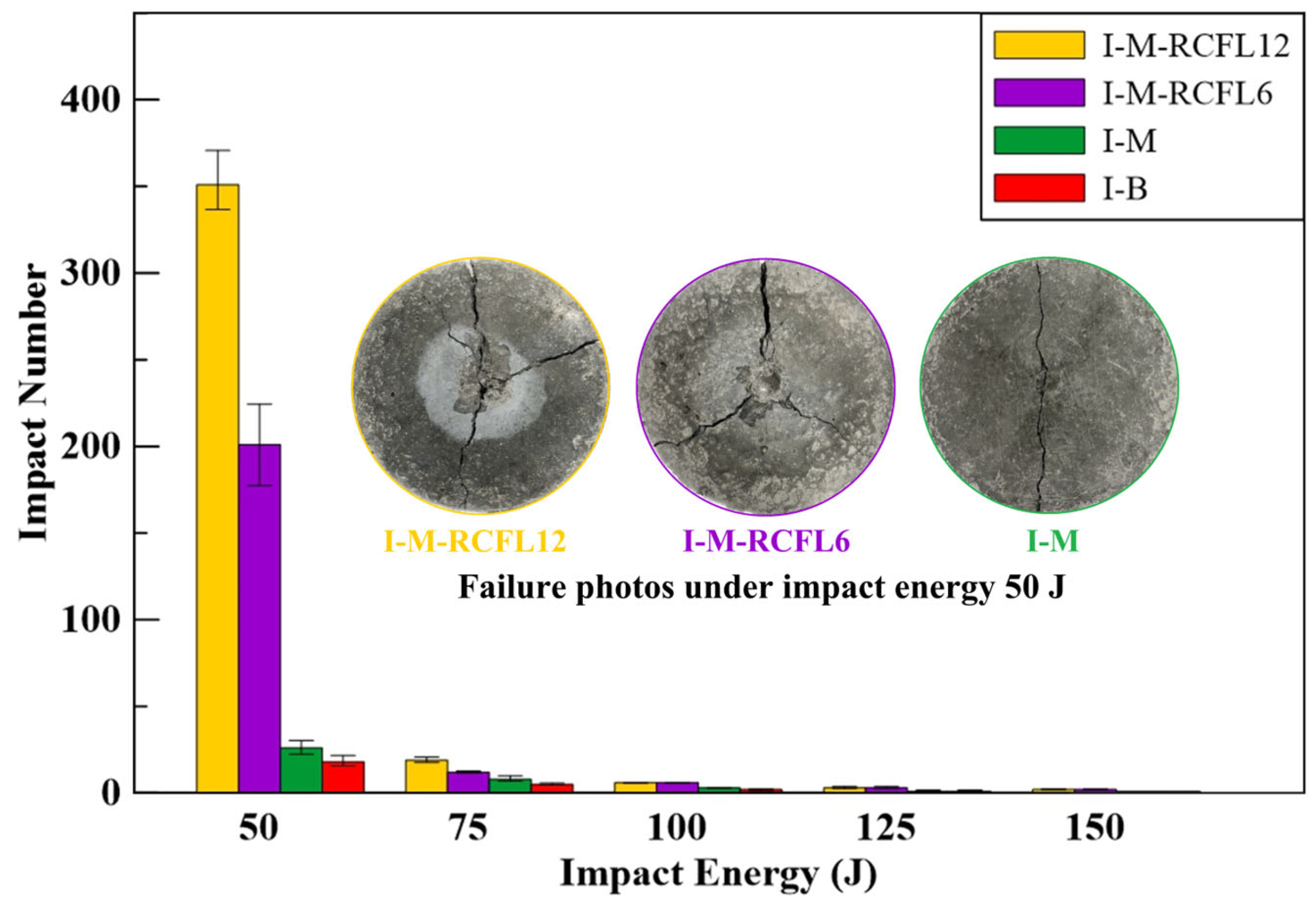
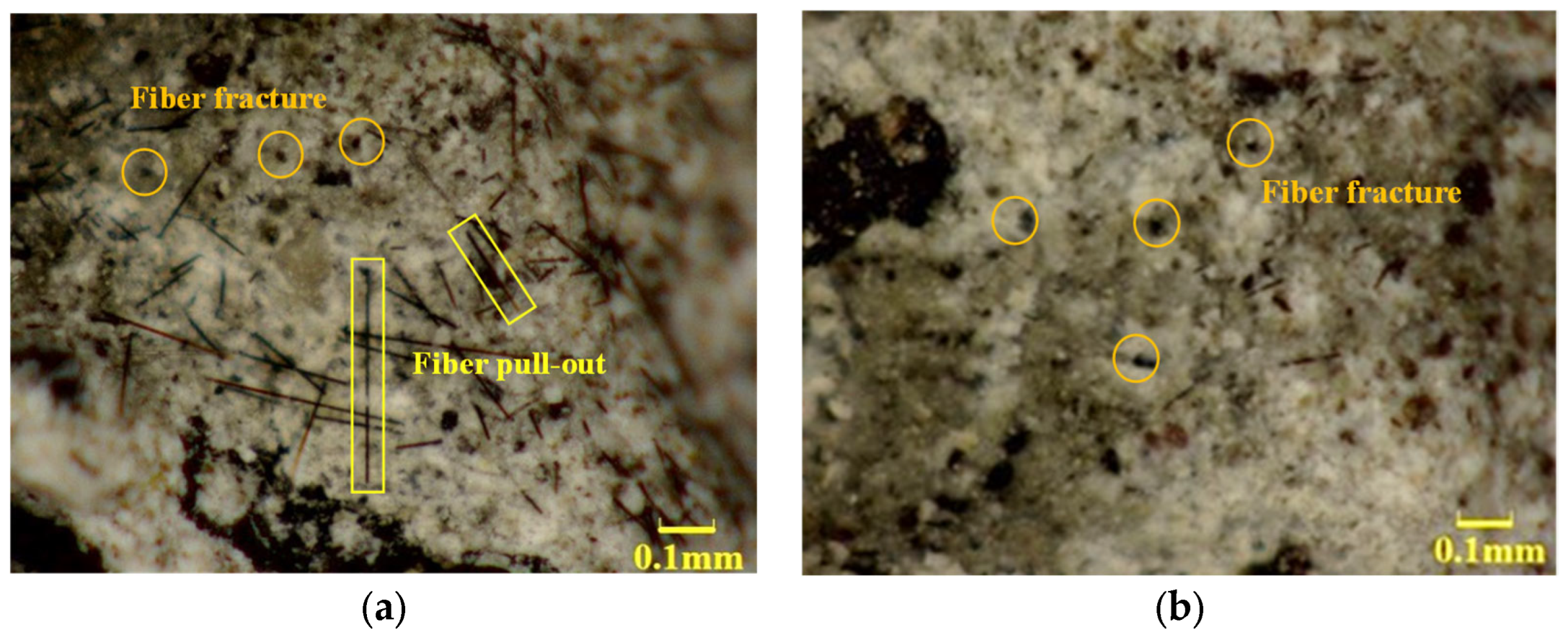
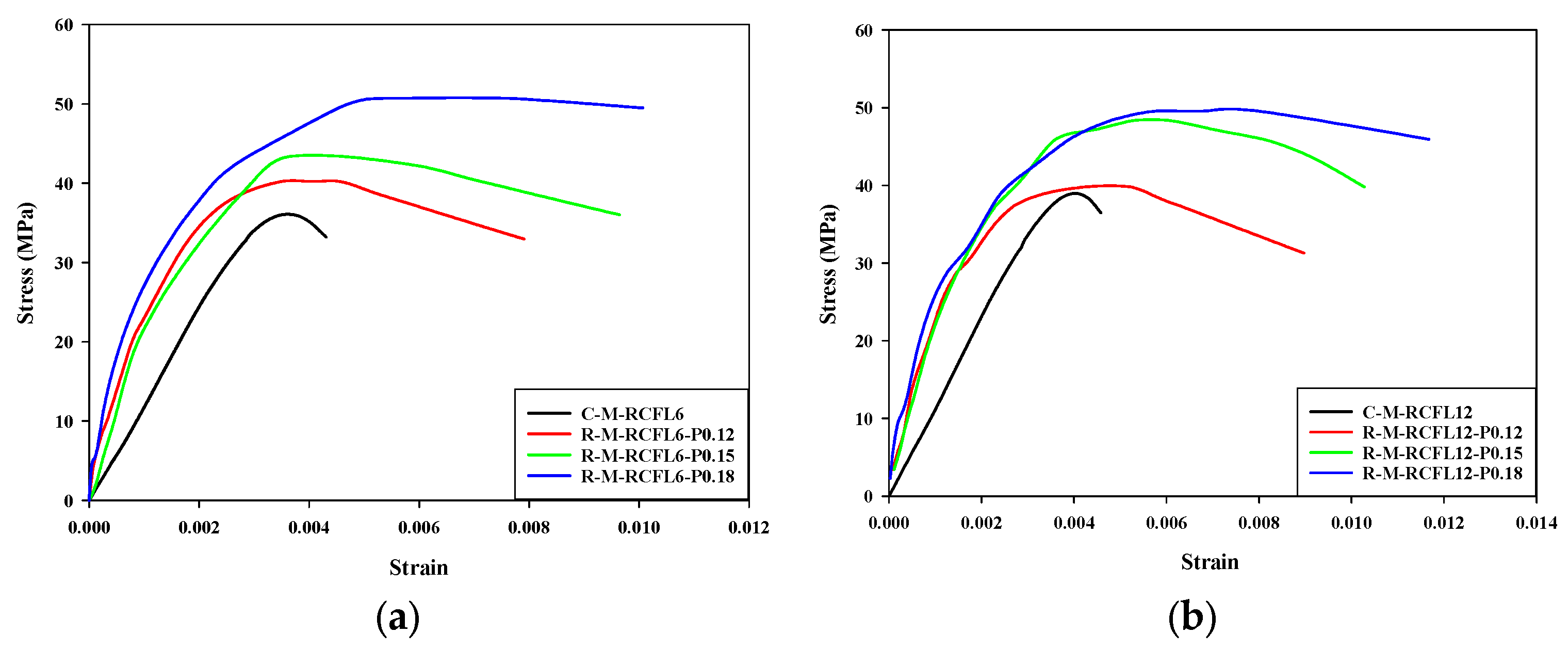


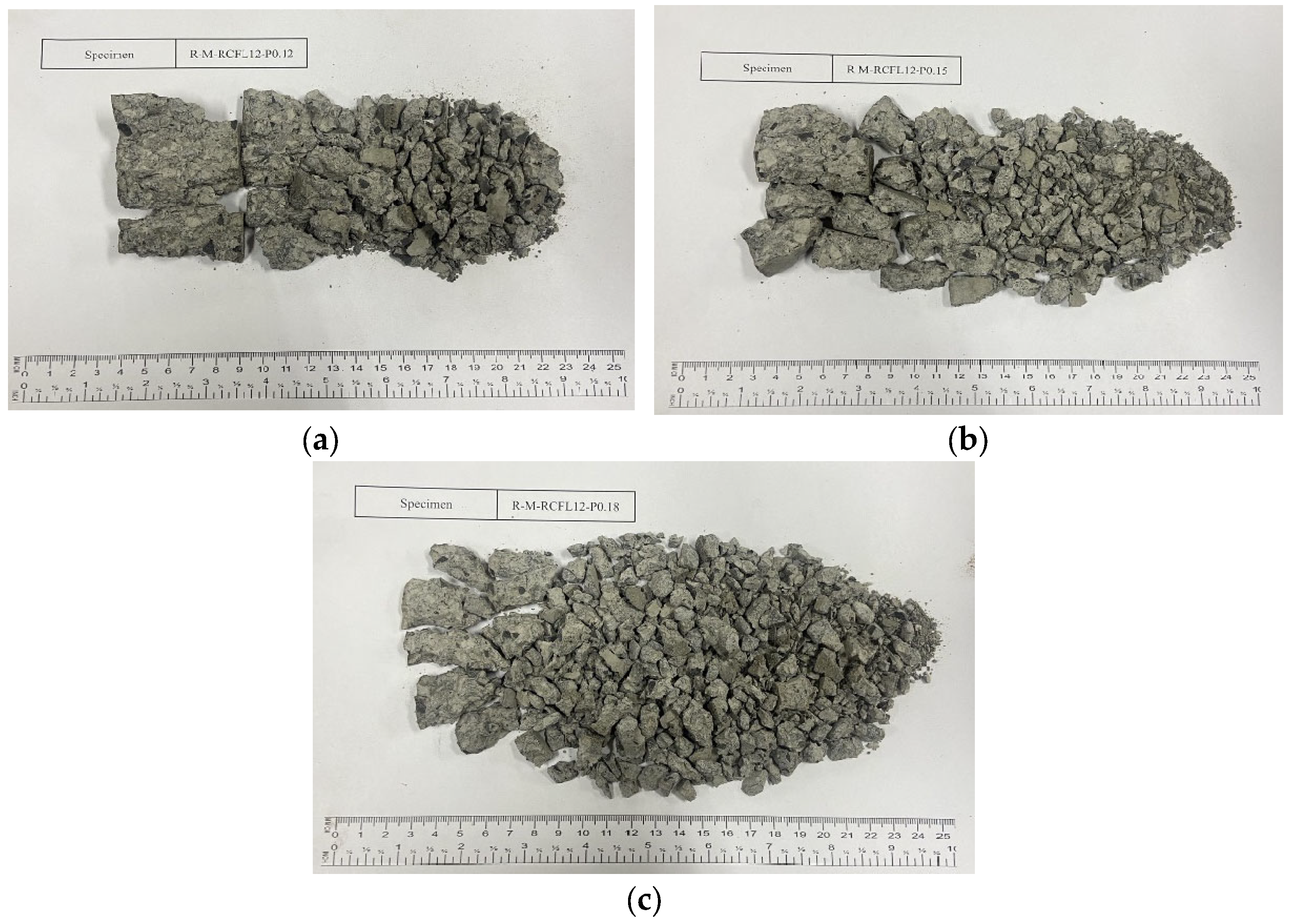


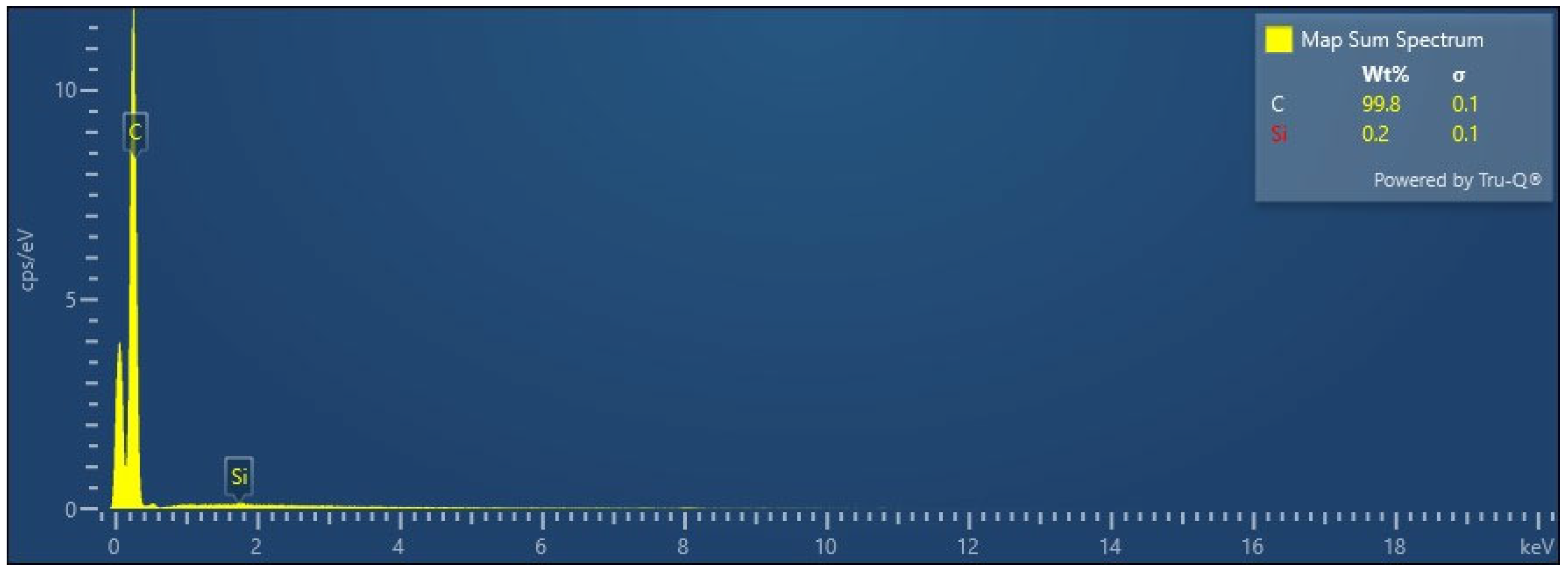

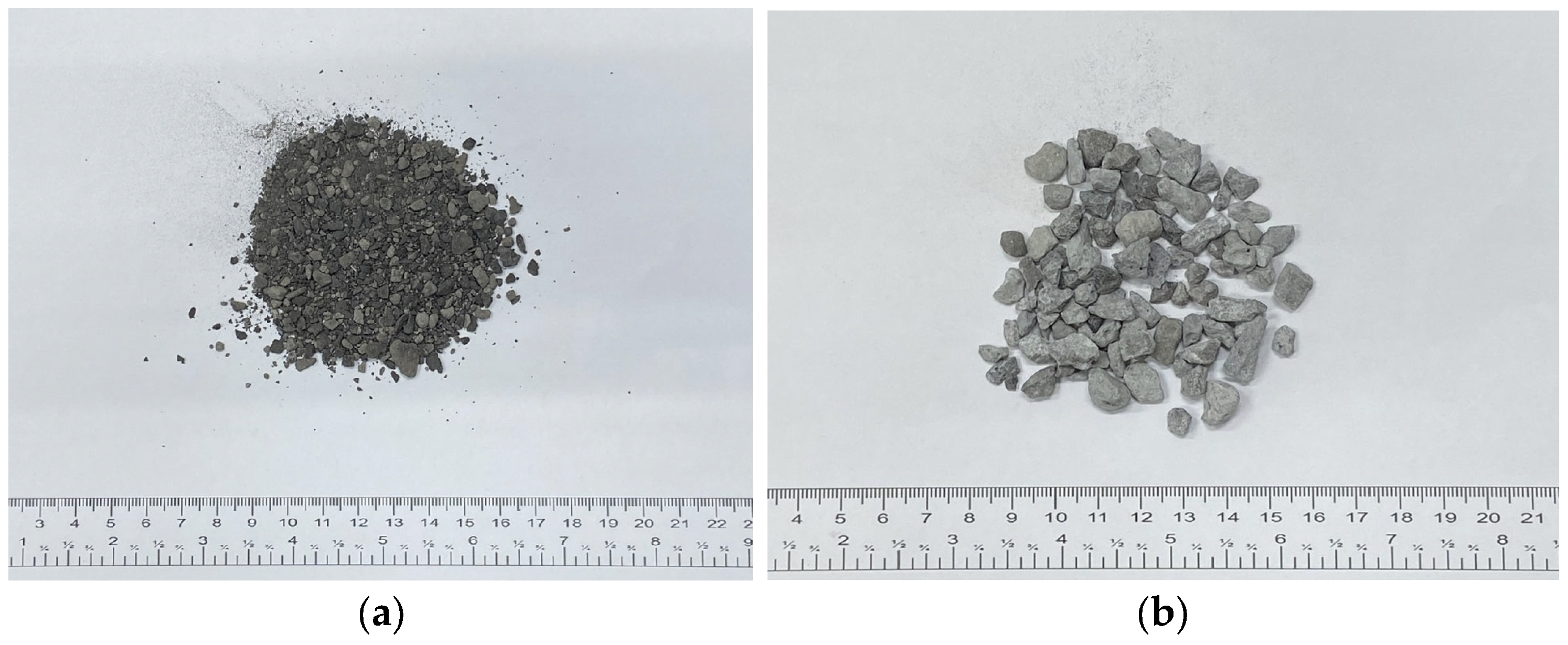
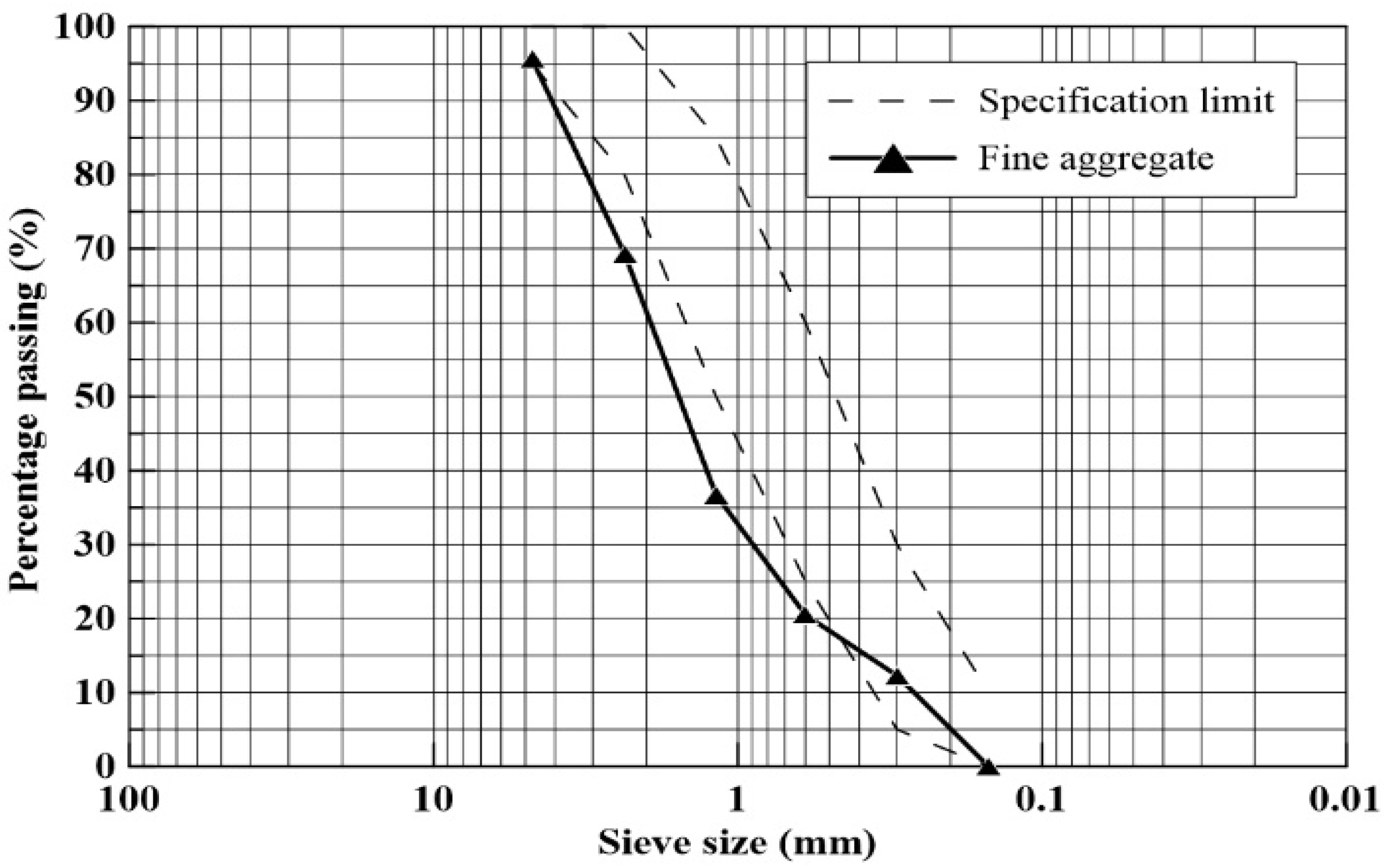
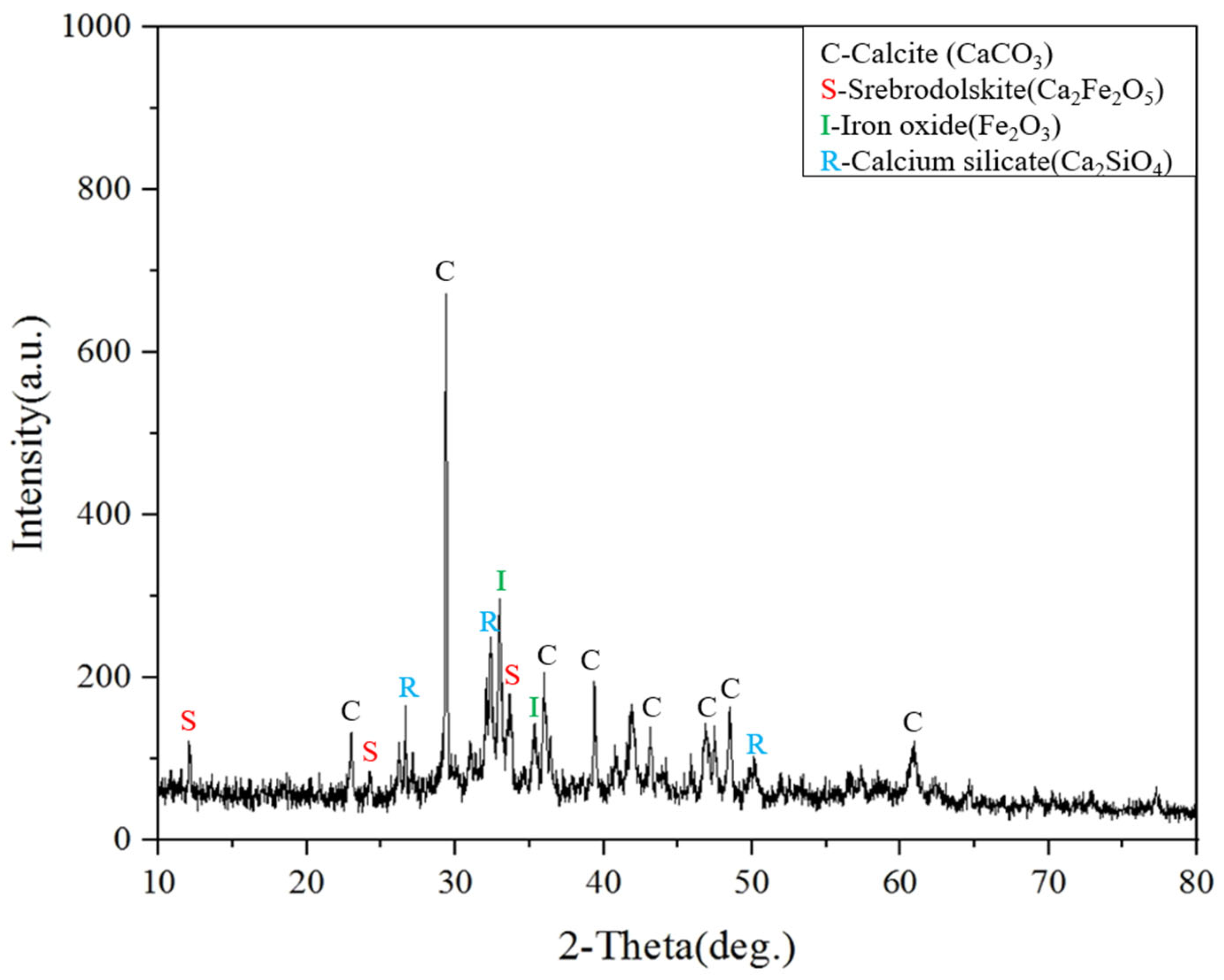
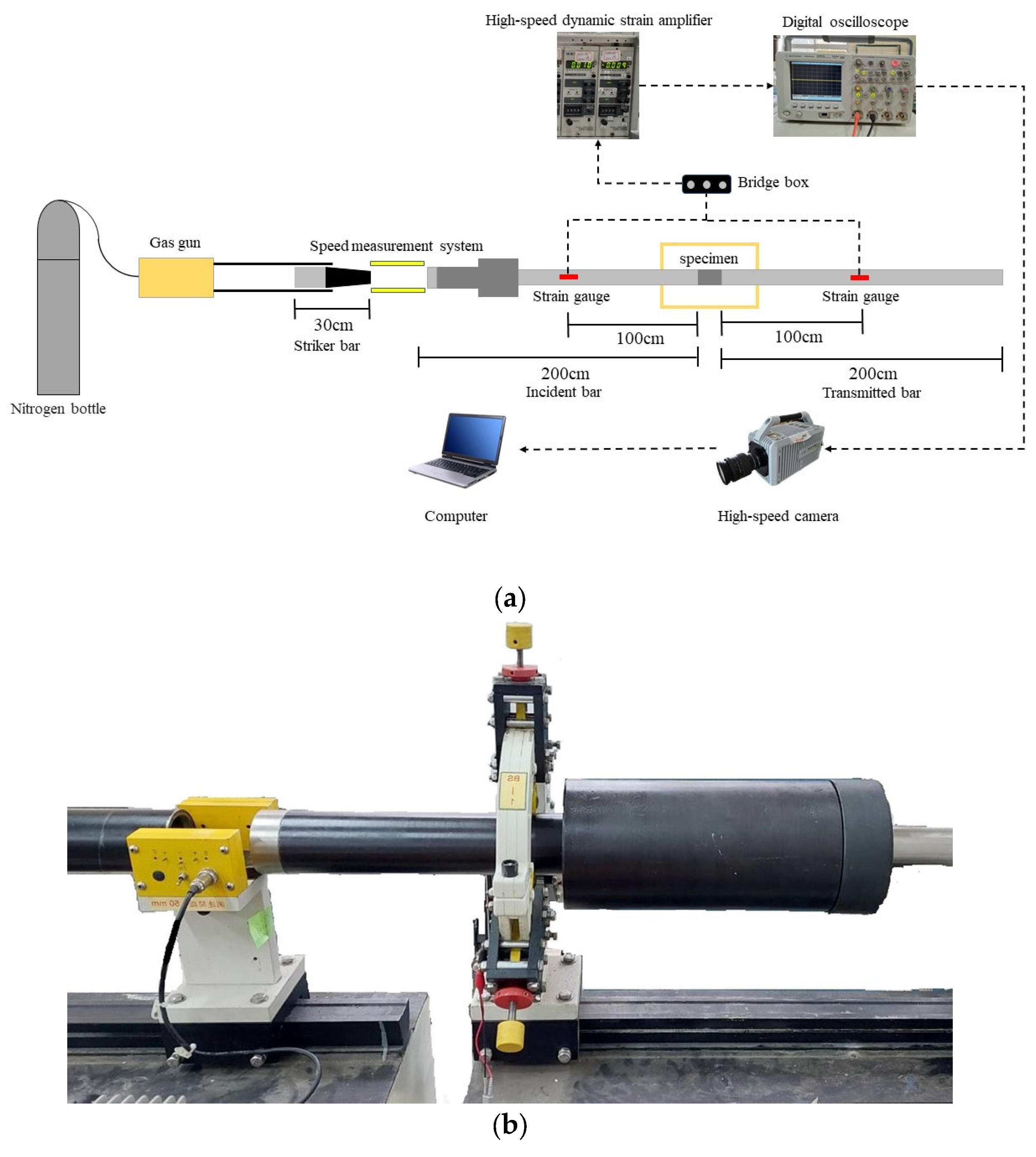
| Specimen | Compressive Strength (MPa) | Average Compressive Strength (MPa) | Increase with Respect to. Specimen C-B (%) | Increase with Respect to. Specimen C-M (%) |
|---|---|---|---|---|
| C-B | 24.35 | 26.11 | – | – |
| 26.01 | ||||
| 27.97 | ||||
| C-M | 35.73 | 34.99 | 34.01 | – |
| 35.72 | ||||
| 33.52 | ||||
| C-M-RCFL6 | 36.14 | 36.05 | 38.07 | 3.03 |
| 36.11 | ||||
| 35.90 | ||||
| C-M-RCFL12 | 40.51 | 39.81 | 52.46 | 13.77 |
| 39.90 | ||||
| 39.01 |
| Specimen | Flexural Strength (MPa) | Average Flexural Strength (MPa) | Increase with Respect to. Specimen F-B (%) | Increase with Respect to. Specimen F-M (%) |
|---|---|---|---|---|
| F-B | 5.67 | 5.73 | – | – |
| 5.72 | ||||
| 5.81 | ||||
| F-M | 6.82 | 6.69 | 16.75 | – |
| 6.63 | ||||
| 6.61 | ||||
| F-M-RCFL6 | 7.69 | 7.66 | 33.68 | 14.50 |
| 7.66 | ||||
| 7.64 | ||||
| F-M-RCFL12 | 8.40 | 8.01 | 39.79 | 19.74 |
| 7.85 | ||||
| 7.77 |
| Specimen | Splitting Tensile Strength (MPa) | Average Splitting Tensile Strength (MPa) | Increase with Respect to. Specimen S-B (%) | Increase with Respect to. Specimen S-M (%) |
|---|---|---|---|---|
| S-B | 2.21 | 2.35 | – | – |
| 2.35 | ||||
| 2.48 | ||||
| S-M | 2.51 | 2.57 | 9.37 | – |
| 2.55 | ||||
| 2.64 | ||||
| S-M-RCFL6 | 2.48 | 2.63 | 12.22 | 2.60 |
| 2.68 | ||||
| 2.74 | ||||
| S-M-RCFL12 | 2.95 | 3.23 | 37.60 | 25.84 |
| 3.31 | ||||
| 3.43 |
| Specimen | Gas Pressure (MPa) | Strength (MPa) | Failure Strain Rate (s−1) | DIF |
|---|---|---|---|---|
| C-M-RCFL6 | - | 36.05 | 0.0001 | 1 |
| R-M-RCFL6 | 0.12 | 40.26 | 103.68 | 1.12 |
| 0.15 | 43.32 | 113.09 | 1.20 | |
| 0.18 | 50.71 | 191.25 | 1.41 | |
| C-M-RCFL12 | - | 39.81 | 0.0001 | 1 |
| R-M-RCFL12 | 0.12 | 39.79 | 102.34 | 1.00 |
| 0.15 | 48.31 | 170.09 | 1.21 | |
| 0.18 | 50.81 | 237.47 | 1.28 |
| Specific Gravity | BOF | Natural |
|---|---|---|
| Original specimen weight (g) | 2000 | 2000 |
| Oven-dry weight (g) | 1992 | 1995 |
| Saturated-surface-dry weigh (g) | 2014 | 2004 |
| Specimen weigh in water (g) | 1416 | 1253.7 |
| Bulk specific gravity | 3.33 | 2.66 |
| Apparent specific gravity | 3.46 | 2.69 |
| Absorbed moisture (%) | 1.12 | 0.45 |
| Moisture content (%) | 0.40 | 0.24 |
| Oxide | CaO | Fe2O3 | SiO2 | MnO2 | Al2O3 | MgO | P2O5 | Others |
|---|---|---|---|---|---|---|---|---|
| Weight (%) | 37.67 | 32.28 | 14.25 | 4.07 | 1.98 | 2.50 | 1.31 | 5.94 |
| Materials | Proportion |
|---|---|
| Cement | 1 |
| Water | 0.55 |
| MBOF sand | 1.65 |
| MBOF aggregate | 2.475 |
| RCF | 0.01 |
| Specimen | Notation |
|---|---|
| Benchmark | B |
| MBOFs | M |
| Recycled carbon fiber | RCF |
| Length (mm) | L6, L12 |
| Test | Notation |
|---|---|
| Shrinkage test | SA |
| Compressive test | C |
| Splitting tensile test | S |
| Flexural test | F |
| Impact test | I |
| RSHPB test | R |
Disclaimer/Publisher’s Note: The statements, opinions and data contained in all publications are solely those of the individual author(s) and contributor(s) and not of MDPI and/or the editor(s). MDPI and/or the editor(s) disclaim responsibility for any injury to people or property resulting from any ideas, methods, instructions or products referred to in the content. |
© 2025 by the authors. Licensee MDPI, Basel, Switzerland. This article is an open access article distributed under the terms and conditions of the Creative Commons Attribution (CC BY) license (https://creativecommons.org/licenses/by/4.0/).
Share and Cite
Li, Y.-F.; Lin, H.-S.; Syu, J.-Y.; Lee, W.-H.; Huang, C.-H.; Tsai, Y.-K.; Shvarzman, A. Investigating the Static and Dynamic Mechanical Properties of Fiber-Reinforced Concrete Incorporating Recycled Carbon Fiber and Modified Basic Oxygen Furnace Slag Aggregate. Recycling 2025, 10, 206. https://doi.org/10.3390/recycling10060206
Li Y-F, Lin H-S, Syu J-Y, Lee W-H, Huang C-H, Tsai Y-K, Shvarzman A. Investigating the Static and Dynamic Mechanical Properties of Fiber-Reinforced Concrete Incorporating Recycled Carbon Fiber and Modified Basic Oxygen Furnace Slag Aggregate. Recycling. 2025; 10(6):206. https://doi.org/10.3390/recycling10060206
Chicago/Turabian StyleLi, Yeou-Fong, Hung-Sheng Lin, Jin-Yuan Syu, Wei-Hao Lee, Chih-Hong Huang, Ying-Kuan Tsai, and Asia Shvarzman. 2025. "Investigating the Static and Dynamic Mechanical Properties of Fiber-Reinforced Concrete Incorporating Recycled Carbon Fiber and Modified Basic Oxygen Furnace Slag Aggregate" Recycling 10, no. 6: 206. https://doi.org/10.3390/recycling10060206
APA StyleLi, Y.-F., Lin, H.-S., Syu, J.-Y., Lee, W.-H., Huang, C.-H., Tsai, Y.-K., & Shvarzman, A. (2025). Investigating the Static and Dynamic Mechanical Properties of Fiber-Reinforced Concrete Incorporating Recycled Carbon Fiber and Modified Basic Oxygen Furnace Slag Aggregate. Recycling, 10(6), 206. https://doi.org/10.3390/recycling10060206








